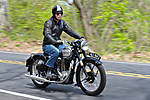Quoted Text
Hi Joel.
I am with Rowan regarding "Eyeball MkI" when it comes to colours. Official colours have come to mean little to me regarding model paints. As an artist of little talent it is obvious for the need to approximate tint and hue to the circumstance of the subject and modelling is really art in 3-D.
The Dark Earth-Dark Green scheme is very familiar to me as the "Battle of Britain" is where my main interest lies. Having painted British model aircraft in prescribed, original tones I soon became disappointed by dark, ugly blobs of plastic. Only when I started to look at paintings by excellent aviation artists did I realise the natural colours appeared quite different from those mixed in a laboratory. Humbrol 30 and Humbrol 26 became a base-line, with different mixing of greens or browns to them to suit the subject in hand. I simply apply the impression of a camouflaged aeroplane that may be fresh or worn. No two are exactly the same. Dark Earth on a model "appears" different when the Dark Green is applied, so the green I use for Bf109's is the same as for a Hurricane, the grey changing the green to the eye.
Colour is something easily done if you take your time, and above all trust your own judgment.
Cheers
Karl.
Karl
Thanks so much for your advice, it's much appreciated. I have zero artistic talent and can't really even draw a straight line free land. If a piece of paper didn't have lines on it, I could never write a single line that was anywhere considered straight.
I've always prescribed to the theory that during war time, every paint manufacture used whatever pigments and bases it could procure. Hence not only did colors vary from manufacture to manufacture, but batch to batch. That doesn't negate what the official paint chip was called out in the specs. Only the interpretation of real world applications under less then idea circumstances.
So where do that leave us Modelers? Does one match colors to a currently made paint chip made with inks, or to a 70 year old piece of fabric or metal chip from the actual aircraft that's in all likelihood nowhere close to what the color was when applied in 1940? Beats me.
Grumman's didn't get the Gov't to approve of Grumman Gray because Mr. Grumman loved the color, it was because they couldn't get the specified interior primers locally on LI. And Grumman Gray varied from batch to batch that even Dana Bell can't come up with the definitive chip for it.
The more modern the aircraft or whatever you're modeling, the easier it is to attain the original color. At least in theory that is.
Personally, I long ago gave up on trying to duplicate a specific color so precisely that it became an obsession. My brother still spends weeks and months trying to do so, and we constantly argue over just how accurate those colors are. To me close enough is good enough. Especially because I weather all my models to some degree.
Joel



















































